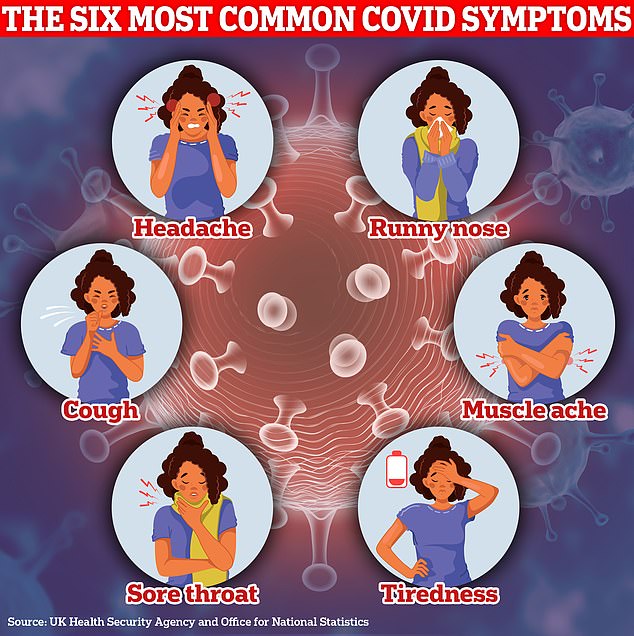The REAL nightmare before Christmas: Covid rates double in a fortnight with up to one in 16 people now infected in worst-hit parts of UK
Covid is sweeping Britain again, with infections more than doubling in just a fortnight.
According to surveillance data, one in 24 people in England and Scotland had the virus in the week to December 13, up from one in 55 two weeks earlier.
But that figure rises to one in 16 in London – the worst affected area, according to figures from the UK Health Security (UKHSA) and the Office for National Statistics (ONS).
The number of virus-related hospital admissions is also increasing, the NHS has warned.
Health chiefs fear the outbreak will continue to grow in coming weeks as more people socialize indoors over Christmas and New Year.
The joint UKHSA and ONS data includes responses from 150,000 participants and 30,000 lateral flow test results per week.
The data shows that 4.2 percent of people in England and Scotland (2.5 million) became infected in the week to December 13.
This is more than double the 1.8 percent recorded in the previous two weeks, to November 29.
In In England, around 4.3 percent (2.3 million) were infected with Covid in the past week. In Scotland this figure was 215,000 (4.1 percent).
Professor Steven Riley, director general for data and surveillance at the UKHSA, said: 'At this time of year, the cold weather, shorter days and increased social contact mean the risk of transmission of respiratory viruses such as Covid is particularly high .'
'This, as well as the potential impact of new variants, means it is not unexpected that the number of cases is increasing.'
Within the English regions, the figures were highest in London and South East England, where they were 6.1 and 4.8 percent respectively.
They were followed by the East of England with 4.4 percent.
It was meanwhile lowest in both the East and West Midlands, with both recording a rate of 3.4 per cent.
The data also showed that cases appear to be highest among young people aged 18 to 44.
Rates among 18- to 34-year-olds have nearly tripled in a month, with 5.8 percent recorded on December 13, up from the 2.1 percent recorded on November 14.
Among 35 to 44-year-olds, the percentage was also 5.7 percent, an increase from 2 percent on November 14.
The infection rate was lowest among the elderly, with a rate of 2.6 percent on December 13, among 65 to 74-year-olds and 2 percent among people aged 75 and older.

However, UKHSA chiefs noted that the sample size used to estimate prevalence for each age group is smaller than the sample size of the overall study, meaning there is greater uncertainty compared to national infection estimates.
Current levels of Covid infections are in line with those seen in mid-January, when cases fell from the winter peak of around 1.7 million, according to a separate Covid monitoring project by health tech company ZOE.
However, separate NHS data released today shows that the number of Covid cases in hospitals is also increasing, by more than a third in the last four weeks.
As of December 17, there were 3,390 virus patients in hospital, an increase of 38 percent from the 2,452 recorded on November 19.
This is also an increase of 12 percent in one week compared to the 3,024 registered reports on December 10.
For weeks, health chiefs have been warning of a rise in cases and hospital admissions due to Omicron subvariant JN.1, which vastly outperforms every other known strain.
UKHSA chiefs have named it an official variant, with the name V-23DEC-01. The process means that it is followed formally.
It was first noted by the UKHSA as part of a routine program designed to assess emerging infections flagged due to a troublesome mutation in the spike protein, which is known to help the virus evade the body's immune system.
UKHSA leaders noted that the specific tension was also escalating internationally and in Britain.
However, the number of Covid-19 infections is still far from the level of earlier in the pandemic.
The number of infections rose to 4.3 million last winter during the rollout of the original Omicron – but this was surpassed a few months later when the number reached a record 4.9 million.
The threat of Covid has been drastically reduced by the wall of immunity built up by vaccines and infections.
As such, it can now typically cause an illness similar to the flu in many people, unlike the potentially fatal symptoms we experience in 2020.
However, a potential rise in cases would cause chaos for the NHS, which is already seeing a rise in the number of patients with norovirus, flu and RSV.
Health chiefs have urged those eligible to get their flu and Covid booster jabs to reduce the risk of becoming seriously ill and needing hospital care.
They urged Britons to turn to pharmacies and local urgent treatment centers where necessary, as the rising number of virus patients continues to worsen emergency department delays.
Professor Riley said: 'If you are showing symptoms of Covid or other respiratory conditions, you should try to limit your contact with other people as much as possible, especially those who are older or more vulnerable.'
He added: 'It is important that the people most at risk of severe illness and hospitalization from Covid come forward for their seasonal vaccination to ensure they have the best possible protection this winter.
'You can get a vaccine through your GP, by booking with a local NHS vaccination service, or you can find a Covid vaccination walk-in site.'
